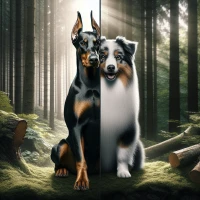My Journey with a Doberhound
It all started one sunny Saturday afternoon when my brother Jimmy and I decided to visit a local animal rescue center. We weren’t exactly sure what we were looking for, but we knew we wanted a dog—a unique, loving companion. Enter Max, the incredible Doberhound, a fascinating mix of a Doberman Pinscher and a Greyhound.
Adopting Max was one of the best decisions we ever made. I remember the first time I laid eyes on him. His sleek, muscular build and those big, soulful eyes immediately drew me in. But adopting Max came with its own set of challenges—and victories!
What Exactly is a Doberhound?
For those who might not be in the know, a Doberhound is a hybrid breed, a cross between a Doberman Pinscher and a Greyhound. These dogs are known for their incredible speed, agility, and loyalty. Physically, they’re quite the spectacle—a slender build that oozes both strength and grace.
Dobermans are known for their protective nature and sharp intellect, while Greyhounds are renowned for their speed and gentle temperament. Together, they create a dog that’s not only capable of running like the wind but also obedient and affectionate. What a combo, huh?
Physical Characteristics
When it comes to physical appearance, Doberhounds are quite the head-turners. They typically inherit the Doberman’s sleek coat and the Greyhound’s streamlined physique. Max, for example, has a shiny black coat with patches of brown and an elongated snout that gives him a discerning look. His ears, although floppy, perk up at the slightest sound. Trust me, he hears everything—even that sneaky squirrel in the backyard!
These dogs are usually medium to large in size, standing around 24 to 28 inches tall and weighing anywhere between 60 to 90 pounds. Despite their size, they are incredibly graceful and have an almost feline agility.
Personality Traits
Max is a delightful blend of both his parent breeds’ personalities. He has the loyalty and protectiveness of a Doberman, always watching over my nieces and nephews when they come over. Yet, he has the gentle, laid-back nature of a Greyhound. When he’s not guarding the house, you can find Max lounging on the couch, often looking like he owns the place.
Training and Socialization
Training Max wasn’t exactly a walk in the park, but it was definitely worth it. Doberhounds are highly intelligent, sometimes to a fault. This intelligence means they pick up commands quickly but can also become bored easily. Keeping training sessions short and fun was key.
I remember the first time I tried teaching Max to sit. He gave me one of those “Really?” looks but figured it out within minutes. He’s a quick learner, no doubt.
Socialization is another crucial aspect. Max was naturally a bit wary of strangers, but with gradual exposure to different people and environments, he became more accepting and relaxed.
Exercise Needs
Doberhounds are high-energy dogs and need plenty of exercise to stay happy and healthy. Max is no exception. Every morning, rain or shine, we take him for a long run. And boy, can he run! It’s like watching an Olympic sprinter in action.
If you’re considering adopting a Doberhound, remember that these dogs need a lot of mental and physical stimulation. Puzzle toys, obstacle courses, and fetch games are all great ways to keep them entertained.
Health Considerations
It’s essential to be aware of the potential health issues that Doberhounds can face. Both parent breeds have their own set of health concerns. For instance, Dobermans are prone to hip dysplasia and heart conditions, while Greyhounds often face issues like bloat and bone cancer.
Regular vet check-ups are a must. I make it a point to take Max for a thorough examination every six months. Early detection is key, and it helps to have a vet who understands the unique needs of a hybrid like the Doberhound.
Diet and Nutrition
Feeding Max is a task that I don’t take lightly. Given his active lifestyle, he requires a high-quality, protein-rich diet. I’ve found that a mix of dry kibble and wet food keeps him healthy and satisfied. A little tip—always make sure the dog food has real meat as its first ingredient. It makes a world of difference.
Max also enjoys the occasional vegetable treat. Carrots and sweet potatoes are his favorites. Just remember not to overdo it on the treats, as Doberhounds can be prone to weight gain if their diet isn’t properly managed.
Living Conditions
Doberhounds thrive in homes where they have plenty of space to run and play. If you live in an apartment, be prepared to make frequent trips to the dog park. They aren’t couch potatoes, and lack of exercise can lead to destructive behavior. Imagine coming home to a chewed-up couch—not fun!
Grooming Requirements
One aspect I particularly love about Max is his low-maintenance grooming needs. His short coat only requires a weekly brush to keep shedding in check. A bath once a month is sufficient unless he decides to roll in something smelly, which he has a knack for doing!
I also keep a check on his ears and nails. Regular ear cleaning and nail trimming are essential to avoid infections and discomfort.
Doberhounds and Families
Max has proven to be an excellent family dog. He’s incredibly gentle with kids and gets along well with other pets. My cousin has a cat, and believe it or not, Max and the cat are best buddies. They even nap together sometimes—it’s adorable!
That being said, always supervise interactions between dogs and young children. It’s just good practice to ensure everyone’s safety.
The Joy of Owning a Doberhound
Every dog has its quirks, and Max is no different. He has this hilarious habit of “talking” to us, especially when he wants attention or treats. It’s like he believes he’s part of the conversation—well, maybe he is!
Owning a Doberhound is a rewarding experience. Their unique mix of traits makes them incredibly versatile and loving companions. Whether you’re looking for a guard dog, a running partner, or a family pet, the Doberhound fits the bill perfectly.
Random Facts
Did you know that Greyhounds can run up to 45 miles per hour? That’s faster than some cars! And Dobermans were originally bred by a tax collector in Germany who wanted a loyal and protective companion. When you combine these histories, you get a highly capable and fascinating mix—a Doberhound.
Reflecting on Life with Max
Overall, adopting Max has been one of the most fulfilling experiences of my life. He’s not just a pet; he’s family. Every wag of his tail and every playful bark adds joy to our home. If you’re considering adding a dog to your family, I highly recommend looking into Doberhounds. They bring a beautiful blend of loyalty, speed, and affection to the table.
In closing, thank you for taking the time to read about my adventures with Max. Remember, a dog isn’t just a pet; they’re a lifelong companion who fills your life with countless happy moments.
Catch ya later, and may your days be filled with wagging tails and slobbery kisses! 🐾










